|
|
|
Sort Order |
|
|
|
Items / Page
|
|
|
|
|
|
|
| Srl | Item |
| 1 |
ID:
090811
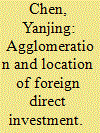

|
|
|
|
|
| Publication |
2009.
|
| Summary/Abstract |
This paper investigates the effect of agglomeration on foreign direct investment (FDI) location in China. We use different measures of agglomeration, and test both within and across region agglomeration effect. The results suggest that urbanization, foreign-specific agglomeration and industry diversity have positive impact on FDI location. Urbanization, foreign-specific agglomeration and industry specialization, also significantly promote industrial FDI. The results also suggest there exist both within and across region agglomeration effects. Other factors including market size, wage, education, road density, government policy and trade cost also have significant impacts on FDI location.
|
|
|
|
|
|
|
|
|
|
|
|
|
|
|
|
| 2 |
ID:
106232
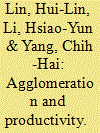

|
|
|
|
|
| Publication |
2011.
|
| Summary/Abstract |
Is the spatial concentration of manufacturing activity able to enhance firm-level productivity? This question is particularly relevant to production in China, which has a huge territory and population, but a skewed distribution in terms of urban-rural development. This paper aims to examine the dynamics of industrial agglomeration and the impact of agglomeration on firm-level productivity in China's textile industry by using a firm-level panel dataset from 2000 to 2005. First, the average value of the Ellison-Glaeser (EG) index (city level) is found to be approximately 0.00019. Moreover, the calculated city EG index of spatial concentration for each year exhibits a decreasing trend of spatial agglomeration for garments and other fiber products, but an increasing trend for the textile industries' agglomeration in China. The above findings are similar to the findings of Lu and Tao (2009). Secondly and importantly, this study finds an inverted U-shape relationship between agglomeration and productivity. It suggests that while industrial agglomeration enhances firms' productivity, agglomeration diseconomies may appear if the degree of agglomeration is too high.
|
|
|
|
|
|
|
|
|
|
|
|
|
|
|
|
| 3 |
ID:
143433
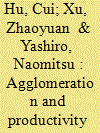

|
|
|
|
|
| Summary/Abstract |
This paper conducts an in-depth evaluation on the role of industrial agglomeration in productivity growth of China's industrial sector by exploiting large dataset of manufacturing firms active in 176 three-digit industries and in 2860 counties. We also complement our analysis with the 2004 Census data to capture the agglomeration of small firms. Unlike previous studies that often focused on specific industries, we assess the impact of agglomeration in a comprehensive range of industries and extend the scope of analysis to upstream industries as well. Moreover, we explore how the ownership of Chinese firms shapes their ability to benefit from agglomeration effect as well as to act as the source of externality. We find that congestion and fiercer competition offset the benefits of agglomeration for firms operating within agglomerated regions. On the other hand, a co-location of large firms contributes significantly to productivity. We also find a more important contribution from the agglomeration of upstream industries than from that of the same industry. Private enterprises are the primary source of agglomeration effects especially in upstream industries, whereas their productivity is boosted most by the agglomeration of other private enterprises. We reckon that industrial agglomeration contributed up to 14% of the productivity growth in China's industrial sector between 2000 and 2007.
|
|
|
|
|
|
|
|
|
|
|
|
|
|
|
|
| 4 |
ID:
162632
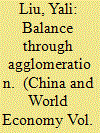

|
|
|
|
|
| Summary/Abstract |
Changes in regional income gaps in China reflect the role of both the market and the government in the Chinese economy. Since 2003, government policies have aimed to distribute more resources to less developed areas. Although this process is accompanied by a narrowing interregional income gap, it does not represent real “convergence” between regions. From the perspective of spatial–political economics, the free movement of people is helpful to realize regional economic balance through agglomeration, while investment policies that deviate from the comparative advantage of less developed regions may lead to spatial misallocation of resources and unsustainable economic growth. In order to achieve further integration and development in the Chinese economy in the future, restrictions to the flow of production factors must be alleviated so that the market can truly become a decisive force for the allocation of resources.
|
|
|
|
|
|
|
|
|
|
|
|
|
|
|
|
| 5 |
ID:
130748


|
|
|
|
|
| Publication |
2014.
|
| Summary/Abstract |
Recently it has been reported in the technical literature that carbon nanotubes (CNTs) have distinct effects on thermal, mechanical and electric properties of epoxy resins. Compared to single-walled nanotubes (SWCNT), multiwalled nanotubes (MWCNT) apparently show greater improvements. The maximum aspect ratio (L/D) of CNT is reportedly as high as 138,000,000. In addition, the carbon nanotubes when treated with surface modifier to generate functional groups on their surface can afford to provide better improvement of the properties of the epoxy based CNT-particulate composite system. There are a number of factors that can influence the properties of epoxy-CNT systems. This paper examined the technical contents from selective references and made an attempt to highlight the general understanding of the properties and performance of epoxy - CNT particulate composite systems
|
|
|
|
|
|
|
|
|
|
|
|
|
|
|
|
| 6 |
ID:
103948


|
|
|
|
|
| Publication |
2011.
|
| Summary/Abstract |
This article provides empirical evidence of the inefficiency of contracting institutions (measured by high switching costs) among surgical instrument producers in Sialkot, Pakistan, even though it is an industrial cluster where manufacturers have access to a multiplicity of suppliers. Following the methodology of Johnson, McMillan and Woodruff (2002), we found that nearly 50 per cent of firms in the sample would reject an untried supplier offering a lower price. The decision to reject a prospective new supplier offering a 10 per cent discount was positively related to the complexity of the input and measures of relational contracting, and negatively related to a belief in informal contract enforcement mechanisms. Firms were more likely to switch to the prospective discount supplier when they were introduced through a business network. Belief in formal contract enforcement was not significant in any of the regressions.
|
|
|
|
|
|
|
|
|
|
|
|
|
|
|
|
| 7 |
ID:
161830
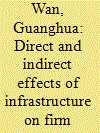

|
|
|
|
|
| Summary/Abstract |
This paper attempts to distinguish and estimate the direct and indirect effects of infrastructure on firm productivity. The latter arises from the infrastructure-agglomeration link and has been largely overlooked in the literature on infrastructure. An analytical framework is then proposed to estimate both effects. Finally, empirical results are obtained using large-scale firm-level survey data from China. Major findings include: (1) all the three kinds of infrastructure–road, telecommunication servers and cable–are found to directly promote firm productivity; (2) they also exert a positive indirect effect on firm productivity through the agglomeration channel; and (3) the empirical results are robust to different agglomeration indicators and different subsamples.
|
|
|
|
|
|
|
|
|
|
|
|
|
|
|
|
| 8 |
ID:
143412


|
|
|
|
|
| Summary/Abstract |
Knowledge spillover from the agglomeration of exporters can reduce the initial costs of exporting faced by other firms and thereby facilitate exports. We use a large dataset of Chinese manufacturing firms to assess whether industrial agglomeration lowers the minimum productivity level required for exporting and whether it increases a firm's probability of exporting. Semi-parametric quantile regressions reveal that the productivity advantage of exporters against non-exporters is markedly smaller in agglomerated regions. Furthermore, a parametric estimation of an export entry model indicates that the agglomeration of incumbent exporters contributes significantly to export participation, although its magnitude is limited. These spillover effects are generated not only by the agglomeration of exporting foreign invested firms (FIFs), but also, more importantly, by that of indigenous Chinese exporters. In fact, the agglomeration of exporting FIFs only contributes to the export entry of FIFs.
|
|
|
|
|
|
|
|
|
|
|
|
|
|
|
|
| 9 |
ID:
124554
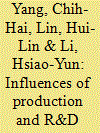

|
|
|
|
|
| Publication |
2013.
|
| Summary/Abstract |
As China adopts a government-supported agglomeration model to develop high-tech industries, it is crucial to examine whether the spatial concentration of manufacturing and R&D activities enhance firm-level productivity. Based on a panel dataset of Chinese electronics firms from 2005 to 2007, the calculated Ellison-Glaeser (EG) index indicates that both production and R&D activities are highly spatially concentrated. Crucially, we find that production agglomeration has a positive relationship with firms' productivity, especially for smaller firms. In contrast, R&D agglomeration seems to negatively relate with productivity. It implies that the possible congestion effect and/or free rider problems erode the benefit derived from knowledge spillovers.
|
|
|
|
|
|
|
|
|
|
|
|
|
|
|
|
| 10 |
ID:
128156
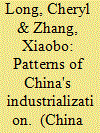

|
|
|
|
|
| Publication |
2012.
|
| Summary/Abstract |
This paper presents a few stylized facts on the patterns of China's industrialization by computing a set of multi-dimensional measures on industrial concentration, regional specialization, and clustering based on census data at the firm level in 1995 and 2004. Our results show that China's rapid industrialization is characterized by the following patterns: industries have become more spatially concentrated; regions have become increasingly specialized; and firms have become more interconnected, both within industries and within regions. In addition, the number of firms is growing faster in clustered areas than non-clustered ones. Together these patterns suggest that China's industrialization process is largely cluster-based-a phenomenon in which a large number of highly interconnected firms are located within a well-defined geographic region.
|
|
|
|
|
|
|
|
|
|
|
|
|
|
|
|
| 11 |
ID:
118589


|
|
|
|
|
| Publication |
2012.
|
| Summary/Abstract |
The author of the article examines the specific features of the development of urbanization in the Republic of Korea and its influence on the system of urban settlement of the country's population in the latter half of the 20th-beginning of the 21st centuries. He also describes the role of urbanization in intensified commuting and greater disproportion of population distribution.
|
|
|
|
|
|
|
|
|
|
|
|
|
|
|
|
|
|
|
|
|